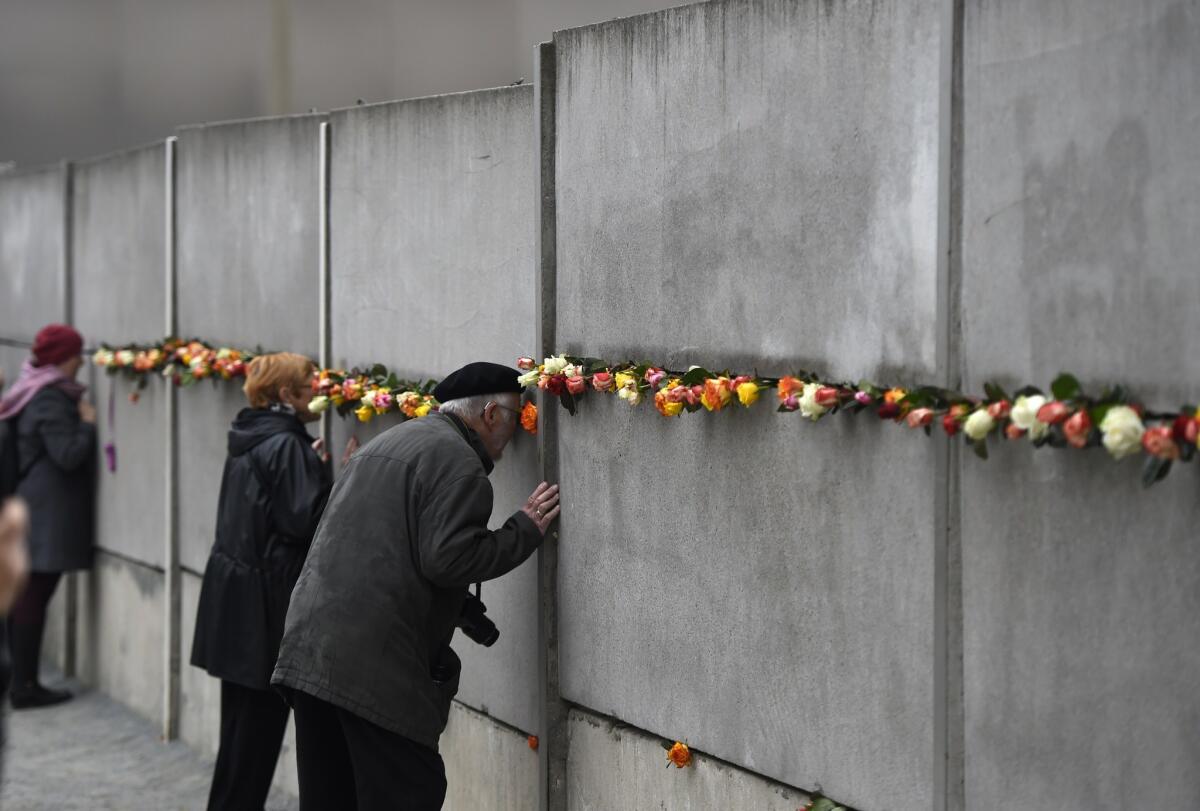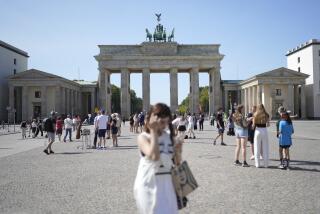Raucous party follows somber recollections at Berlin Wall

A day that began in mournful contemplation ended in a raucous street party for hundreds of thousands as Germany marked the 25th anniversary of the collapse of the Berlin Wall.
The split nature of the commemorations — downbeat trumpets in the morning, gyrating pop stars at night — reflected the silver anniversary’s strange duality. A quarter of a century after it came down, the wall still evokes both some of modern Europe’s darkest hours and hardest-fought triumphs, and in this nation of 80 million its demise is at once an occasion for sober reflection about its many victims and cause for rejoicing over its representation of the Cold War’s abrupt end.
Under chilly gray skies, dissidents and dignitaries gathered Sunday morning in a residential section of central Berlin next to an extant portion of the wall that has been refurbished as a memorial. With a former East German watchtower looming behind her, German Chancellor Angela Merkel received a flower from one of dozens of goodwill child volunteers and joined them and others in placing the blossoms in spaces in the wall.
Shortly after, Merkel told officials and journalists that the message of the wall continued to resonate.
“This concrete symbol of state tyranny brought millions to where they could not tolerate it anymore,” Merkel said. “But we have the power to create. We can change things for the good.”
Sunday evening, entertainers of all stripes took the stage outside the Brandenburg Gate, the ornate landmark that separated East and West Berlin and where numerous leaders, including Ronald Reagan, gave famous Cold War speeches.
The festivities contained some political content — after nodding to Mikhail Gorbachev on a dais, Berlin Mayor Klaus Wowereit drew enthusiastic cheers of “Gorby” from the crowd — but for the most part music and revelry reigned.
Conductor Daniel Barenboim led the Berlin State Opera orchestra in a spirited performance of Beethoven’s Ninth Symphony, a callback to a Barenboim-led performance of Beethoven’s Seventh in Nov. 1989.
Peter Gabriel performed his 2010 cover rendition of “Heroes,” the song David Bowie famously sang, in German, during a Cold War concert in West Berlin.
Various German pop stars, youth choirs and performance dancers took the stage in acts meant to reflect the era of the wall. An elaborate fireworks display was also launched and Wowereit presided over the unleashing of lighted balloons into the sky; the orbs, which had been affixed to temporary stands, had traced the path of the Berlin Wall for nine miles around the city this weekend.
The East Berlin-raised techno musician Paul Kalkbrenner did after-hours duty, assembling electronica tracks for the throngs while the Brandenburg Gate behind him was turned into a canvas for a strobing light show.
But perhaps the night’s strangest turn came when the Cold War-era pop star Udo Lindenberg took the stage. The freewheeling singer had a key role during the era of the wall — he’d played a show in East Berlin in the early 1980’s, rallying the city’s youth, and also is the inspiration for “Beyond the Horizon,” a current hit musical about love divided by the Berlin Wall.
After performing numbers from the show, Lindenberg proceeded to camp it up, using a microphone cord as a lasso (a trademark move) and kissing numerous female performers. He also high-fived a man in a Berlin bear costume and danced suggestively with a scantily clad woman who descended by crane from a neon hoop in the sky. Then Lindenberg ascended a giant birdcage of sorts and drifted away over the crowd.
Berliners might have needed a release after the daytime events.
At the flower-placing memorial on the city’s once-divided Bernauer Street, dissidents described the “tears of blood” that ran through the city because of the Cold War-era divide. In the now-fashionable neighborhood of Mitte, Merkel and Wowereit stood just feet from the “death strip,” the shoot-to-kill buffer zone where an estimated 138 people were slain trying to escape East Germany.
As a neighborhood in the center of Berlin, Mitte was both one of the most prominent areas to be sealed off when the wall went up unexpectedly in August 1961 — and, with its condos and restaurants that have sprung up in recent years, ground zero for the revitalization that has occurred since the wall fell.
The Bernauer memorial in particular has become a place for the city to process its darker memories.
It is the result of a relatively recent phenomenon of Berliners looking to preserve their wall history instead of razing it. Large swaths of grass have been planted in spots where much of the death strip stood, creating an odd juxtaposition both with the metal pillars that once supported the wall just beyond it as well as a preserved section of the death strip itself. Ringing the site is a formidable expanse of concrete that brings home the wall’s fearsome quality.
In her only scheduled remarks of the day, Merkel — herself a product of East Germany — cited Lech Walesa, Gorbachev and other reformers from the era, noting regions where today “freedom and human rights are still threatened or even trampled on.”
Her speech was notable because it also cited Kristallnacht — the anti-Jewish pogroms in 1938 that also began on Nov. 9 — and took a turn to the political with references to the wars in Syria and eastern Ukraine. They were quick mentions, in the context of a larger fight for just causes, but the latter underscored Merkel’s increasing split with Moscow on the Donetsk situation. On Friday, Merkel said she had “grave concern” about Russian President Vladimir Putin’s actions in the region after she talked to Ukrainian President Petro Poroshenko.
Gorbachev didn’t miss an opportunity either, excoriating the U.S. and Europe in his own speech Saturday for bringing the world to “the brink of a new Cold War.”
The comments served as a reminder that Europe’s divisions, particularly between East and West, haven’t disappeared and in some ways have resurfaced in the 25 years since the wall fell.
Around Berlin, there were other commemorations Sunday morning.
At the modern entertainment hub of Potsdamer Platz, once a no man’s land between the city’s sectors, tourists and visitors posed alongside sections of the wall that had been placed there for the anniversary.
An outdoor Jumbotron near the Bernauer memorial played East German propaganda and drew a crowd of hundreds, while inside a train station visitors perused an exhibit explaining the concept of “ghost stations” — East German metro stops that had been sealed off after the city was divided but that trains still ran through to get between points in West Berlin.
But things were perhaps most personal on Bernauer Street. An unassuming residential avenue, the road in central Berlin contains historical significance because of the proximity of homes on its east and west. Residents could see from one side to the other, and in more lenient moments in the 28-year history of the wall, East Berliners from other parts of the city could visit apartment dwellers on the street and attempt to see family members in the West without fear of retribution from East German authorities. There were also numerous escapes from the East that were attempted over, under and across the boulevard.
An exhibit has been set up explaining the odd concept of East and West within eye line of each other, and in recorded interviews, residents of the street described the peculiar interactions they inspired.
In one, a woman named Ursula Gesch told of being unable to return home upon coming back from a holiday out of the country to find the wall had gone up. To keep in contact with family members who had been stranded in East Berlin, her parents “would visit friends with a window that allowed them to see us across the road.” she said. “And my parents would stroke their hair in such a way so that we knew they’d seen us.”
More to Read
Sign up for Essential California
The most important California stories and recommendations in your inbox every morning.
You may occasionally receive promotional content from the Los Angeles Times.











